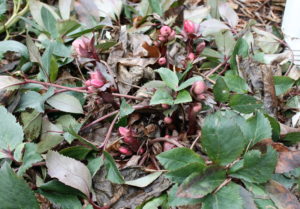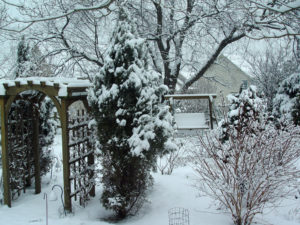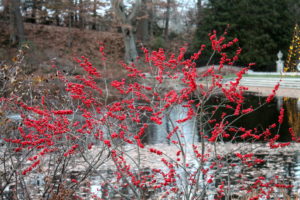The Landscape in Winter
November 13th, 2018
Back when winter-long snow-covers were the norm, plants and their leafless skeletons were little more than different forms of white sticking out above the snowy sea.
But now that winter typically gives us at least periodic spells of bare ground, the winter landscape is no longer a three-month write-off. Cold weather no longer means your yard is doomed to be barren.
Free of white frosting, a surprising number of plants look pretty decent in winter. However, unless you get lucky, it takes planning to have a landscape that makes the most of our fourth and forgotton season.
Needled evergreen trees and shrubs are the most obvious example. Relegated to background and screening status during the growing season, evergreens take on starring roles when the flowers die back.
We have much more to pick from than just green evergreens, though. Choices also come in shades of blue and gold, not to mention a wide range of shapes, textures and growing habits.
Blue junipers, blue spruce, concolor fir and blue cedars are needled evergreens at their best after a snow – or spotlighted at night by landscape lights.
Golden- and yellow-needled Hinoki cypress, goldthread cypress, and junipers are superb for adding bright color during those snow-free periods when the predominant color is lifeless brown.
Toss in broadleaf evergreens such as azaleas, rhododendrons, boxwoods, nandina, and cherry laurel, and you’ve got plenty to give structure and life to the winter landscape.
Hollies, for instance, have attractive bluish-green leaves all winter, and the females give the bonus of red berry clusters that persist most of winter.
Nandina is a broadleaf evergreen whose leaves turn red from late fall through much of winter.
Many types of euonymus have white and green variegated leaves, giving a wintery feel (at least when scale insects haven’t caused the leaves to drop).
And some types of camellias now sold at local garden centers are hardy enough to survive Harrisburg-area winters, giving us the possibility of rose-like flowers even before spring arrives.
Be sure to mix at least a few small to mid-sized evergreens around the house so you don’t have bare foundations all winter.
Consider spotting a few of the larger, specimen evergreen trees at key spots such as house corners, property corners and out windows where you’ll be able to enjoy them from inside.
Trees and shrubs aren’t the only plants that are evergreen in winter here.
Many perennial flowers are cold-hardy enough that they hold their leaves all winter, too.

This helleborus plant is still green and already putting out flower buds, even though it’s February.
Some are green, such as the popular groundcovers ivy, pachysandra and vinca, but others offer multi-colored foliage whenever snow isn’t smothering them.
Two of the best are coralbells and foamflowers (plus the cross of those two, foamybells). Many varieties of these foot-tall plants have two-toned leaves that range from purple to burgundy to silver to lime-green.
Lamium is a creeping evergreen perennial with white-edged leaves, ajuga is an evergreen creeper that comes in rose and burgundy-variegated forms, and liriope is a grass-like perennial that comes in a showy white-variegated form.
Helleborus or Lenten rose is a glossy evergreen that actually flowers at winter’s end. Bergenia, dianthus, creeping phlox, candytuft, barrenwort, and hardy geraniums are other perennials that stay green at least through some winters.
Then there are plants with berries. Many plants produce fall berries, but birds quickly polish them off before winter arrives.
A few aren’t bird favorites, and so they give us a good winter show until the birds finally can’t find anything any better.
The best example is winterberry holly. The females of this leaf-dropping holly species have red or gold berries all along their bare stems when pollinated by a suitable male.
They’re especially striking in winter along a back border with tall evergreens behind them as a green curtain.
Viburnums, blue hollies, pyracantha, and hawthorn trees are other plants with showy winter fruits. Some rose varieties also produce colorful “hips” that look like berries at the end of stems.
Interesting bark is another subtle plant beauty that becomes much more apparent in winter.
The peeling white bark of birch is the most familiar, but other attractive “peelers” are paperbark maple, river birch, paperbark cherry, ninebark, and oakleaf hydrangea.
Others flake off bark to give a Dalmation-like appearance. Some of the best are Korean and Japanese stewartia, crape myrtle, Kousa dogwood, Persian parrotia, and yellowwood.
And in the not-so-subtle bark department are red-twig dogwoods and coralbark maple – two woody plants with bright red stems and branches in winter.
Finally, don’t be too quick to clean out the gardens in fall. Many seed heads, spent blooms, and even browned-out foliage lend nice textural touches to the yard in winter.
Many gardeners let their ornamental grasses stand all winter, for example, because they like the wispy (albeit brown) blades that swish around in winter winds.
The balls and cones of various hydrangea blossoms look like dried bouquets for much of winter, and the umbrella-shaped seed heads of spent sedum flowers hold up nicely for months.
Thanks to all-weather pots, it’s possible to spot a few containers on the front porch or back patio. Instead of living flowers, stick cuttings into the soil. Good possibilities: evergreen prunings, sprigs of berried shrubs, red-twig dogwood stems, a small bundle of ornamental grass and a few clipped, dried seed heads or blooms.
With good “bones” to your garden (walls, fences, arbors, benches, strategically placed boulders, etc.), you might even end up liking your winter landscape better than your summer one.
If nothing else, at least weeds won’t be giving you as much trouble.
Ten particularly nice plants for winter interest:
Hinoki cypress ‘Crippsii.’ An upright, pyramidal evergreen with soft golden needles. 15’ x 8.’ Sun or part shade.
Winterberry holly ‘Winter Red.’ A female, leaf-dropping holly that produces a heavy set of bright-red, pea-sized berries from fall through winter. Plant ‘Southern Gentleman’ for best pollination. 9’ x 8.’ Part shade.
Holly ‘Red Beauty.’ An evergreen holly with pointed blue-green leaves and large, bright-red fruits held nicely toward the branch tips. Needs ‘Blue Prince’ or ‘Blue Stallion’ for pollination. 10’ x 5.’ Sun or part shade.
Red-twig dogwood. A mid-sized, multi-stemmed shrub that drops leaves in fall to reveal bright-red stems all winter. 6’ x 6.’ Sun to part shade.
Dwarf blue spruce ‘Fat Albert’ or ‘Montgomery.’ Slow-growing, stiff-needled evergreens with steely-blue needles. 10’ x 8.’ Full sun.
Dwarf goldthread cypress ‘Gold Mop.’ A tough, soft-needled, golden evergreen with “thready” twigs and a gently arching habit. 5’ x 5.’ Full sun to light shade.
Harry Lauder’s walking stick. A compact shrub with a contorted branching habit. Way more interesting bare in winter than covered with leaves in summer. 10’ x 8.’ Full sun to light shade.
Weeping Norway spruce. A stiff-needled green evergreen with a graceful weeping habit. 15’ x 6.’ Full sun.
Coralbark maple. A small maple with leaves that turn red in fall, then drop to reveal bark that becomes bright red in winter. 20’ x 15.’ Full sun to light shade.
River birch. A bug-, disease- and rot-resistant leaf-dropping tree best known for its cinnamon-colored peeling bark. 40’ x 25.’ Sun to part shade.










